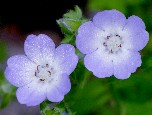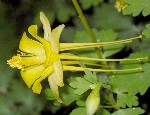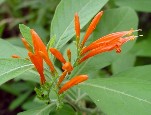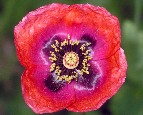




Especially in the springtime, which begins during February in this area, I have a little garden game, which is to see if there is ever a complete complement of rainbow colors in a particular area of our yard. For this purpose, I'm only considering the primary and secondary colors: red, blue, yellow, purple, green and orange. It simply adds icing to the cake to also have white, magenta, pink, lavender, peach, aqua, and all manner of in-between shades.
Our best garden for spring colors is in the back corner of our yard. This is covered by deciduous trees which are very slow to leaf out in the spring and so the ground gets plenty of sun during the cool months. It is also protected from wind by fencing on two sides. During the first months of the year it is a perfect place to sunbathe, and several reseeding annuals take full advantage of this fact. This is also the best garden to produce a rainbow.
Of course, green is a given. There are very few green flowers since they would just blend in with the chlorophyll-filled foliage. The green leaves, however, are present year 'round.
This past winter was rather mild and so some of our plants did not die back as far as they normally would. One of the earliest flowers to bloom this year was our Mexican honeysuckle, a brilliant orange-blossomed plant. True orange is not all that common among our garden flowers, so having the least likely color appear first sort of set the precedent for me to watch to see if the other colors would also show in time.
Very soon after, the next least common color among our garden blossoms, blue, exploded in profusion. The baby blue-eyes, a reliable native understory annual, did very well this past winter because of high rainfall. When they started to bloom, whole sections of that garden turned a lovely sky blue color.
Yellow was an easy one. The first yellow flowers to open were the Texas gold columbines. By this time, there were even some of the "extra" colors as well, including pink evening primrose and the pinkish-purplish Gulf coast penstemon. The garden was starting to take on the satisfyingly gaudy hues that I so enjoy.
A true purple appeared when one of the cultivated species of ruellia started to blossom. This low groundcover tends to stay evergreen during the winter and so was ready to start blooming quite early.
Up until this point, the only hue missing was red. We have plenty of red flowers, but none were yet open in this area. I fully expected that the poppies that were growing so well would eventually add the needed color. What I did not anticipate, however, was the extent to which that color would pop out. Once that first poppy opened, the red just glowed.
As I write this, the garden is still in full rainbow attire. It will stay that way for just a short while longer, as the baby blue-eyes are almost done blooming. Other species will take their place, though, and the parade of colors and blossoms will continue throughout the rest of the year.




